Maximizes ROI: Performance marketing maximizes ROI by paying for specific results only, such as downloads, bookings and sales.
Specific Outcomes: Every dollar you spend in performance marketing is tied to a specific, measurable outcome, making it ideal for smaller budgets.
Measurable. Scalable: It’s a highly measurable and scalable digital marketing approach. You can start small, monitor performance in real time, and adjust your strategy to optimize results.
Since the early 2000s, performance marketing has become a key digital marketing strategy, growing from a niche, experimental practice to a must-have skill for any digital marketing manager.
Digital marketing involves a broad range of channels and strategies - email, social media, influencer marketing, I could go on. With performance marketing, you're able to maximize your impact across these various digital channels from one ad or campaign asset
In this article, we’ll discuss the essentials of performance marketing, including what it entails, how to measure it, and best practices for ensuring your campaigns perform at their best.
What Is Performance Marketing?
Performance marketing is a specific type of digital marketing, also known as pay-for-performance advertising (P4P), in which advertisers only pay for explicit, desired actions, such as sales, bookings, or downloads.
Examples of performance marketing include pay-per-click (PPC), cost-per-thousand (CPM), and cost-per-action (CPA) advertisements.
Since you’re only paying for a specific result, performance marketing delivers more measurable outcomes, uses resources better, and increases your return on investment (ROI).
Benefits of Performance Marketing
Performance marketing is ideal for brands seeking quick, measurable results. It is a low-risk strategy for driving growth within the confines of a tight budget or limited resources.
Here's why:
- Measurable outcomes: You only pay for specific actions, such as sales or downloads, providing clear visibility into your campaign’s efficiency and effectiveness.
- Targeted reach: Your marketing efforts are focused on reaching your ideal audience, maximizing the impact of your campaign by engaging audiences that are most likely to support your goals.
- Scalability: With performance marketing, you can start small and scale as you see success, making it ideal for brands looking to expand their reach.
- Real-time adjustments: Pay-for-performance campaigns deliver real-time data, allowing you to optimize and adjust campaigns quickly and efficiently.
- Cost-effectiveness: Since you only pay for successful actions, performance marketing helps you maximize your budget and resources.
Performance marketing is a great approach for B2B businesses that want to generate leads quickly, build brand recognition, and pinpoint the exact impact of their marketing initiatives.
How Does Performance Marketing Work
To better understand performance marketing, let’s break down the key steps needed to successfully plan, launch, and refine your P4P campaigns.
1. Outline and Align on Your Goals
Set aside time with your marketing team to define clear, measurable goals for your performance marketing strategy and align these objectives with other leaders and stakeholders within your organization.
Examples of common performance marketing goals include:
- Building brand awareness
- Driving website traffic
- Enhancing customer engagement
- Generating leads
- Increasing sales
To set strategic, attainable goals, start by reviewing your brand’s position in the market. Skipping proper market analysis or neglecting to measure brand awareness can lead to vague or unrealistic objectives.
As Mark Ritson points out in his column for Marketing Week:
“More than half the briefs that brands give their agencies this year will be devoid of any actual strategic objectives and more than 60% won’t be clear on who they are even targeting.”
Strong brands can focus on lead generation and sales, while those with low awareness should start with a brand awareness campaign. Once armed with a clear set of goals, you’ll graduate to the next step: audience targeting.
2. Define Your Target Audience
Performance-based advertising delivers high returns by focusing on specific actions, like clicks or conversions. To optimize for these actions, you must have a deep understanding of your audience's needs and behaviors.
Types of data that can inform target audience selection:
- Demographics, including age, gender, income, education, occupation.
- Geographic data, such as location, climate, and population density.
- Behavioral data, including purchasing behavior, brand loyalty, online activity, and past interactions with your brand.
- Psychographics include personality traits, values, interests, and lifestyle choices.
From this data, create detailed buyer personas that describe exactly what your ideal customer wants, needs, and thinks. This in-depth analysis and audience targeting will help improve your brand positioning and messaging.
3. Choose Your Performance Marketing Channels
Next, select the marketing channels that align with your goals and target audience. Opting for an omnichannel approach will allow you to reach your audience across multiple online platforms rather than limiting yourself to just one or two.
Common performance marketing channels include:
- Search engines
- Social media platforms
- Affiliate networks
- Display ads
- Email marketing
Using three or more channels in your campaign boosts audience engagement and produces 494% higher order rates than single-channel campaigns (Omnisend, 2022). For best results, leverage your CRM software to analyze customer behavior and pinpoint the channels your audience frequents most.
4. Create Content for Your Ads
Now that you’ve outlined your goals, audience, and channels, it’s time to create content that will capture attention and drive action. Your ad content should be tailored to each channel and personalized to the needs of your target audience.
To create ad content that drives engagement and results:
- Keep it concise, as attention spans are short.
- Use strong visuals, such as eye-catching visuals, to boost engagement.
- Always include a clear call-to-action (CTA) to make sure your audience knows exactly what to do next.
Focus on creating clear, compelling content that drives action to support campaign objectives. Before proceeding to the next step, take a minute to review and refresh your content marketing strategy.
5. Set Your Bids and Daily Budget
Setting the right bids means choosing the maximum you're willing to pay for actions like clicks, leads, or sales, while your daily budget is the total amount you're willing to spend daily. This ensures your campaign stays cost-effective and drives ROI.
When setting your daily budget and bids:
- Start with a test budget to find the best threshold for your objectives.
- Opt for a strategic approach to bidding rather than just setting the lowest bid. Consider how competitive your industry is and how valuable a conversion is to your business.
- Monitor your bids and budget closely to optimize performance where possible.
Use ad networks like Google Ads or Facebook Ads to set a maximum bid for actions like clicks or conversions. This will help you control your daily spending and avoid exceeding your budget.
Once your bids and daily budget are set, you’re ready to launch.
6. Launch Your Campaign
By now, everything is in place, and it’s time to make the final preparations before your launch. In this stage, you’ll want to be sure you have proper tracking and monitoring tools set up to help you stay on top of your campaign’s performance.
For a smooth campaign launch:
- Create unique tracking codes for campaign URLs, known as UTM tags, to allow close monitoring of traffic sources and campaign performance.
- Install conversion pixels, also known as tracking pixels, on your website or within your email campaigns to track actions like form submissions, downloads, or purchases.
- Double-check platform integrations to ensure that all your marketing platforms (Google Ads, Facebook, email tools, etc.) are properly integrated with your tracking system so you can access real-time data.
- Test, test, and test again to catch any potential issues before going live.
At this point, use tools like Google Analytics to set up detailed tracking for each channel. By handling these steps ahead of time, you’ll launch your campaign with confidence and have all the data you need to make real-time optimizations.
7. Monitor & Optimize Your Campaign
Performance marketing thrives on data-driven optimization. Once your campaign is live, monitor its performance regularly to identify what’s working and where improvements are needed.
To monitor and optimize your campaign:
- A/B test different versions of your ads to pinpoint the exact mix of copy, visuals, and formatting that drives the best results.
- Adjust bids and budgets to reflect performance, such as increasing budgets on high-performing ads and lowering bids on ads that underperform.
- Use real-time data to refine your targeting and focus on audience segments with higher conversion rates.
Ongoing monitoring and optimization help ensure your campaign continues to deliver results and maximize ROI.
5 Primary Types Of Performance Marketing
Performance marketing comes in many forms, each offering unique benefits and strategies to reach your target audience.
Below, learn more about the five primary types of performance marketing and our best tips for implementing them.
Type 1: Native Ads/Sponsored Content
Native advertising refers to ads that blend seamlessly with the platform they appear on. These ads match each platform's feel, look, and function, which helps increase engagement and minimize disruptions to the user experience.
To maximize the performance of native ads:
- Provide value to your audience by aligning your content with their interests and the platform’s content style.
- Prioritize transparency and always mark native ads as sponsored content to maintain trust with your audience.
- Optimize for mobile to be sure your content loads quickly and adequately functions on a mobile device.
Native ads are a fantastic way to boost engagement, click-through rates, and views. For example, when Mediavine rolled out native ads across its network of publishing sites, it experienced a 4X increase in click-through rates and engagement (AdWeek, 2021).
Type 2: Social Media Ads
Paid ads on social media take many forms, including videos, carousel ads, or stories, and offer a flexible and scalable way to target specific audiences.
Similar to native ads, social media ads seamlessly blend into users’ feeds, increasing engagement. Marketers also cite enhanced exposure, traffic, and lead generation as the leading benefits of social media marketing (Statista, 2024).
To maximize the performance of your social media ads:
- Embrace each platform’s unique culture and align your advertisements with these nuances to authentically connect with your audience.
- Use platform-specific features like Instagram Stories or TikTok’s greenscreen templates to drive engagement and increase visual appeal.
- Invest in eye-catching images and videos to help your ads stand out in crowded feeds.
It is best to use social media management software to plan, manage, and schedule your social media marketing campaigns. Experiment with different styles, messaging, and content formats, and use A/B testing to find what works best for your goals.
Type 3: Search Engine Marketing (SEM)
Search engine marketing refers to paid search ads on search engine results pages (SERPs). This form of performance marketing involves bidding on keywords relevant to your products or services so that your ads appear when users search these terms.
This is a highly effective way to capture intent-driven traffic and drive conversions, with Google Search Network Ads producing an average return on ad spend (ROAS) of 800% (Google, 2023).
To maximize the impact of your search engine marketing:
- Optimize your landing pages to be sure that the page users land on is relevant, loads quickly, and is designed to convert.
- Monitor your ad quality scores, such as Google’s quality score, which factors in ad relevance, landing page experience, and click-through rate to determine your ad rankings.
- Use negative keywords to exclude certain search terms irrelevant to your product or service, so your ads will not display under those keywords.
To build search ad campaigns, use tools like Google Ads Keyword Planner or SEMRush to conduct keyword research and competitor analysis. These tools will help you optimize every aspect of your SEM campaigns for the best results.
Type 4: Display Ads
Display ads, which are banners, images, or videos on other websites, apps, or social media platforms, help you reach potential customers. They are great for generating interest, building brand awareness, and retargeting warm leads.
To maximize the performance of your display ads:
- Use contextual targeting by adding keywords or topics to your ad groups, ensuring your ads appear on websites with relevant content.
- Experiment with ad placements on different sites to find where your audience will most likely engage.
- Invest in high-quality, attention-grabbing visuals and clear, compelling copy highlighting your value proposition.
To set up and manage display ads, you’ll need to use a display network like Google Display Network or Facebook Audience Network. Marketing automation tools, such as AdRoll, also offer features to support display ads, including retargeting, automated bidding, and dynamic ad creation.
Type 5: Influencer Marketing
Influencer marketing involves partnering with prominent individuals from specific online communities or niches, typically on social media, to promote your brand. Influencers can range from A-list celebrities to micro-influencers with smaller, more focused audiences.
Influencer marketing is great for targeting specific audiences. Influencers are known for their close connections with their followers, which strongly influence purchase decisions. Almost half of all consumers make purchases at least once a month due to influencer posts (Sprout Social, 2024).
To maximize the performance of your influencer marketing:
- Don’t overlook micro and nano-influencers (under 100,000 followers), as they often drive higher engagement rates.
- Focus on authenticity and let influencers create content in their voice and style to increase trust and authenticity.
- Use unique tracking codes or affiliate links to help you track campaign success and pinpoint the exact influencers and content driving results.
To find influencers who drive real results, look beyond their audience size and prioritize those who understand and align with your brand. Focus on their content quality, engagement rates, post frequency, and the topics they discuss most.
5 Performance Marketing Examples
Performance marketing takes many forms, each offering unique advantages for driving measurable results.
Below are a few key examples of performance marketing strategies and how companies use them to achieve their goals.
1. Affiliate Marketing
Affiliate marketing involves partnering with individuals or other companies to promote your products and services in exchange for a commission on sales. This is a cost-effective way to expand your reach and tap into new audiences.
Amazon Associates is a popular affiliate program that allows bloggers, content creators, and publishers to monetize their traffic by recommending products. Similarly, many SaaS companies, such as Shopify, use affiliate marketing software to reward affiliates with a commission for each business that signs up through their unique referral link.
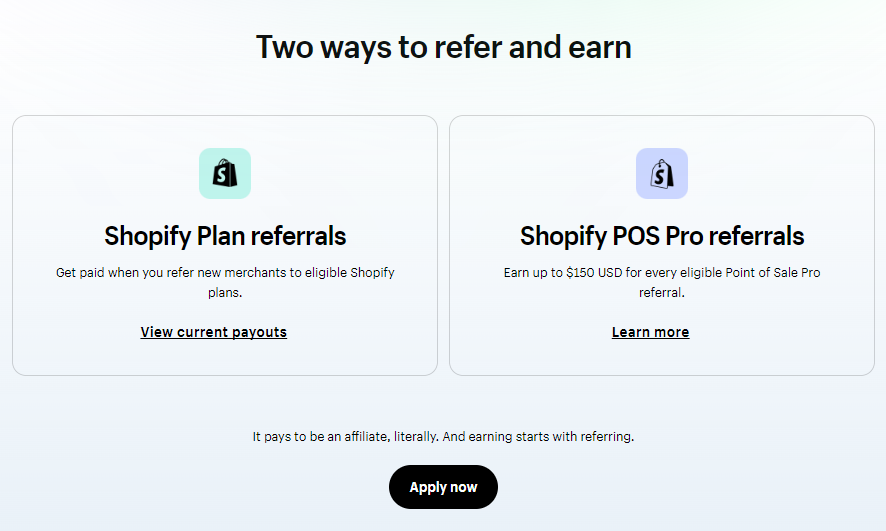
2. Pay-per-Click (PPC) Ads
Pay-per-click ads allow advertisers to pay a fee to display their website on search engine results pages (SERPs) and only pay when users click on their ad. It helps drive targeted traffic to your website, particularly for high-intent users searching for specific solutions.
For example, if you search keywords like “CRM software” on Google, you’ll notice sponsored ads for Hubspot and Monday.com at the top of the SERPs. Hubspot or Monday.com pays a small fee whenever someone clicks on these ads, but the highly targeted traffic makes this a profitable investment.
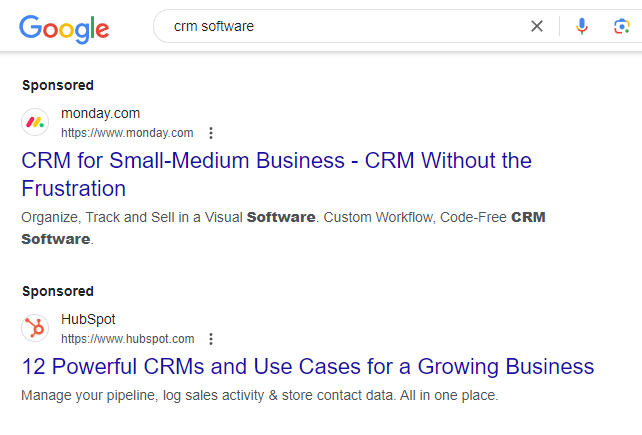
3. Search Engine Optimization (SEO)
In contrast to PPC ads, search engine optimization focuses on creating content that ranks higher in organic search results. This strategy is important for driving long-term, sustainable traffic without direct ad spend and is especially useful for companies looking to grow visibility in competitive markets.
Blogs are a popular content strategy for brands to drive organic search traffic to their website. For instance, the Hootsuite Blog ranks highly for various social media-related search terms, offering how-to guides and answers to common questions. This helps attract a steady stream of organic visitors.
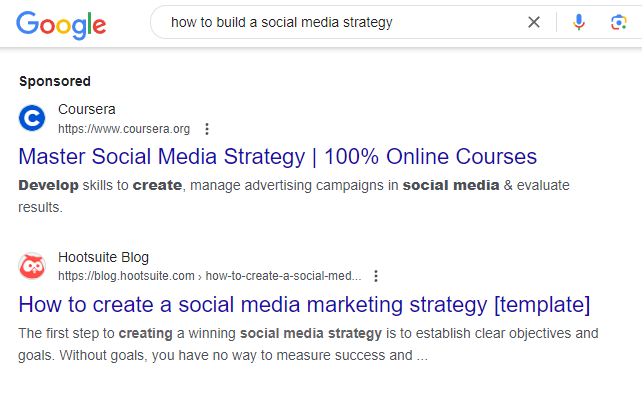
4. Email Marketing
Email marketing directly communicates with potential and existing customers through content like newsletters, promotions, and abandoned cart reminders. It’s an effective way to nurture leads, build relationships, and drive interest in products and services.
For example, Dropbox uses email marketing to re-engage existing customers by promoting new products or features. When Dropbox launched its new collaborative tool, Dropbox Paper, it sent targeted emails to current users, highlighting the tool’s benefits and encouraging them to try it out.
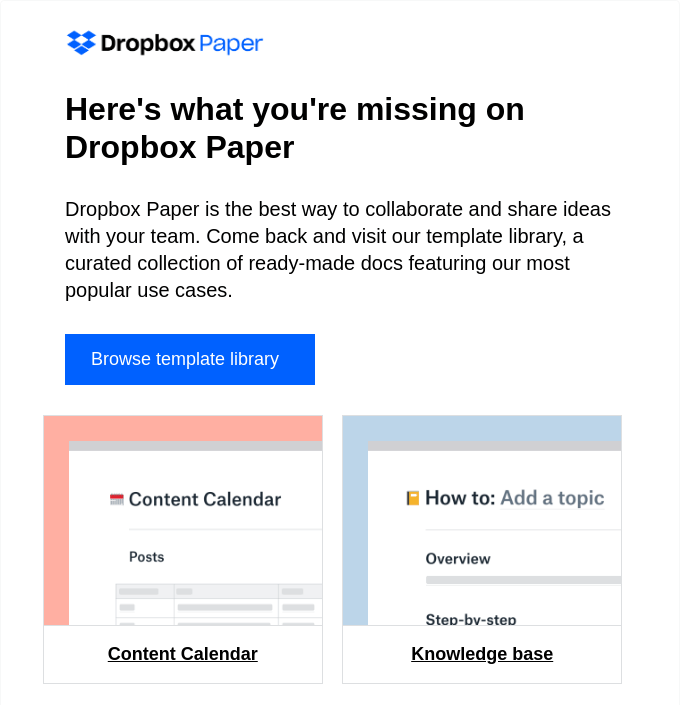
5. Content Marketing
Content marketing involves creating valuable, informative content to attract and engage your target audience. It helps build trust, educate potential customers, and organically drive leads.
Salesforce’s Resource Center is a great example, offering a free library of articles and insights on CRM best practices. This helps position Salesforce as a thought leader while driving traffic to its website and converting readers into paying customers.
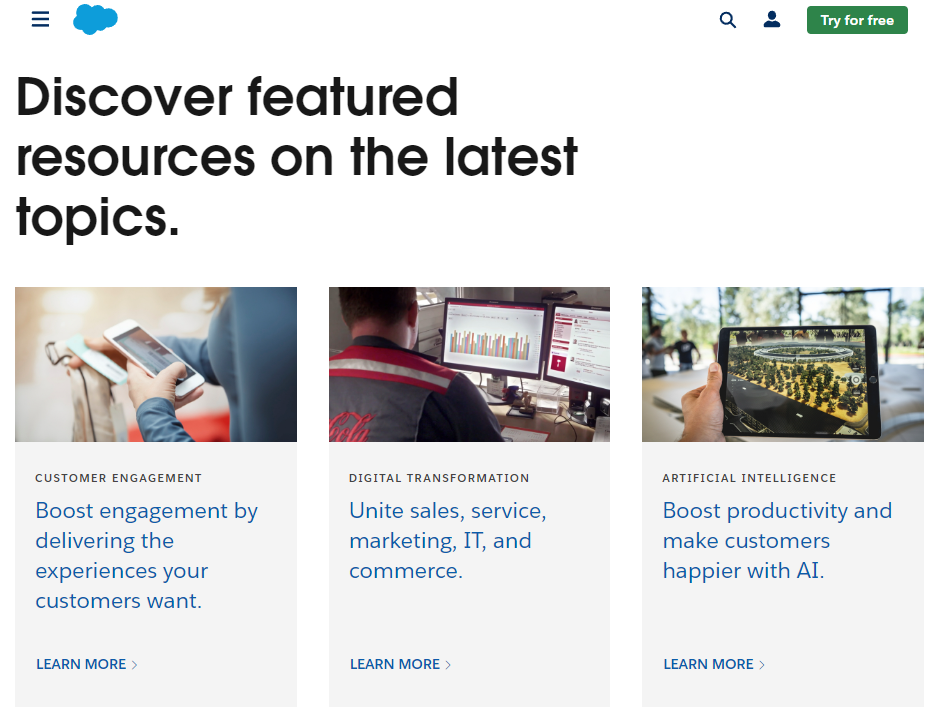
How To Measure Performance Marketing
The key benefit of performance marketing is its promise of performance – but how do you measure it?
To evaluate the impact of your performance marketing campaigns, you must monitor the following key metrics to be sure you’re effectively spending your budget and hitting your targets.
- Cost per Thousand Impressions (CPM):
CPM measures the cost of serving 1,000 ad impressions. It’s a valuable metric for brand awareness campaigns, where the goal is to get your message in front of as many people as possible.
Example: If you’re paying $5 CPM, you’re spending $5 every 1,000 times your ad is displayed.
- Cost-per-Click (CPC):
CPC refers to the amount you pay when someone clicks on your ad. This metric helps you understand the direct cost of driving traffic to your site or landing page.
Example: If you’re running a Google Ads campaign and paying $2 CPC, you’ll be charged $2 every time someone clicks on your ad.
- Cost per Conversion:
The cost per conversion tracks how much you spend to achieve a desired action, such as a purchase, sign-up, or download. It’s an essential metric for determining the efficiency and ROI of your campaigns.
Example: If you spent $100 and generated five purchases, your cost per conversion is $20 per purchase.
- Cost per Acquisition:
CPA measures the cost of acquiring a new customer. It’s an important metric for understanding how effective your campaign is at turning leads into customers.
Example: If you spent $500 on a campaign that resulted in ten new customers, your CPA would be $50.
- Pay per Lead:
PPL, also called Cost per Lead (CPL), reflects the cost for each lead generated from your campaign. It’s commonly used to measure campaigns that collect contact information for future marketing efforts.
Example: If you’re paying $10 per lead for your campaign, you'll be charged $10 every time someone submits their information (through a lead magnet or similar).
- Customer Lifetime Value:
CLV estimates the total potential revenue your business can expect from a single customer throughout its relationship with your company. It’s important to assess the long-term value of the customers you’re acquiring.
Example: If a customer typically spends $500 over their lifetime with your business, and you’re spending $100 to acquire them, you’re making a good ROI.
7 Performance Marketing Best Practices That Guarantee Success
Following best practices is essential to success in performance marketing. This section will cover the key strategies and tactics that will help you optimize your campaigns and drive meaningful results.
1. Create a Good Offer
A strong offer grabs your audience's attention and provides clear value, making it a critical element in performance marketing. Without a valuable offer, even the most eye-catching ad will fall flat.
Quick tips for creating a good offer:
- Make sure your offer is easy to understand and highlights the benefit to your audience.
- Incorporate urgency through limited-time offers or exclusive deals to encourage quicker decision-making.
- Run A/B tests to see which offers, such as discounts or free trials, resonate the most with your audience.
When analyzing and defining your target audience, pay close attention to their pain points. Read competitor’s reviews and look for gaps in their offerings that you can leverage in your advertising. What problems does your audience face, and what are they not getting from competitors? Your offer lies in the answer.
2. Build a Great Landing Page
Once you have a strong offer, it's important to send users to a well-designed landing page that effectively communicates your message and drives conversions. A landing page should be simple, engaging, and directly tied to your offer to ensure users take the desired action.
Quick tips for building effective landing pages:
- Focus on a single goal for each landing page with minimal distractions and clear, concise messaging.
- Include bold, easy-to-find calls to action that guide visitors to the next step, whether signing up, buying, or learning more.
- Design landing pages that are mobile-friendly, and be sure to test them since a large portion of visitors will likely access them via their phones.
A great landing page is essential for converting traffic into leads or customers. To streamline the process and achieve better results, look into tools like Unbounce, which offers no-code landing page builders, templates, A/B testing capabilities, and more.
3. Choose Traffic Sources that are Relevant for Your Product/Service
Not all traffic sources are created equal. To maximize your digital advertising performance, choose channels that best match your audience, products, and services to ensure the highest quality of leads.
Quick tips for choosing the right channels and advertising platforms:
- Use website analytics, social media insights, and search engine reports to identify your audience's channels for product discovery. Focus on metrics like referral traffic, engagement rates, time on page, and conversion paths.
- Include a mix of channels in your marketing plan rather than relying on one traffic source. Experiment with channels like Google Ads, email marketing, and paid social ads to find what works best.
- Check metrics like bounce rates and conversion rates regularly to ensure the traffic from each source is driving meaningful results.
Striking the right channel mix is essential for strong ad performance. If you’re not sure which channels your audience is most likely to frequent, invest in customer relationship management (CRM) software or customer data platform (CDP) to collect and monitor customer behavior in real time.
4. Regularly A/B Test
A/B testing is critical to understanding what works and optimizing your campaigns for the best performance. By regularly testing different versions of your ads, landing pages, and emails, you can make data-driven decisions that will improve results.
Quick tips for performing effective A/B tests:
- Only test one element of your ad at a time, such as headlines, CTAs, or images, so you can pinpoint what drives changes in performance.
- Be sure your audience sample is large enough to draw impactful conclusions, as a test group that is too small can skew results.
- Even if a test performs well, continue to test and optimize to get the absolute best possible results from your campaigns.
A/B testing is a powerful tool for continual improvement and a key marketing tactic for staying on track with business goals. Marketing automation software, like Hubspot or Klaviyo, includes A/B testing features that make it much easier to set up and perform regular tests for your campaigns.
5. Optimize Your Performance Marketing Campaigns for Revenue-focused KPIs
Remember, the main benefit of performance marketing is that your results are measurable, but you must track the right key performance indicators (KPIs) to make sense of this data.
To maximize your marketing budget, prioritize KPIs directly tied to revenue. Track metrics such as cost per acquisition (CPA) or return on ad spend (ROAS) to ensure your campaigns drive profitable results.
6. Be Compliant
While internet marketing presents many business opportunities, it also opens the door to potential security threats and data breaches. When outlining your performance marketing strategy, stay up to date on the latest data privacy laws and platform-specific guidelines.
Ensuring compliance with these laws is necessary to protect your brand and customers. It’s also crucial for maintaining trust with your audience, given that 85% of global adults want to do more to protect their online privacy (Norton, 2022).
Quick tips for maintaining compliance with data privacy laws:
- Set aside time with key stakeholders to regularly review laws like GDPR and CCPA to be sure your marketing practices meet legal requirements.
- Review platform-specific guidelines before a campaign launch to avoid penalties or flagged content.
- Always obtain explicit consent before collecting or using personal data, such as email addresses or phone numbers.
For more information on data privacy laws and how to maintain compliance as a business, check our guide on How To Navigate The Complexities Of Data Privacy Regulations In B2B Marketing.
7. Use the Best Performance Marketing Tools
The right tools can significantly boost the efficiency and effectiveness of your performance marketing campaigns. Tools help automate tasks, track key metrics, and provide insights for optimization, making it easier to manage and scale your efforts.
Quick tips for investing in performance marketing tools:
- Prioritize an all-in-one platform, like Google Analytics, HubSpot, or Zoho Marketing Plus, to manage, track, and optimize your campaigns all in one place.
- Look for automated features such as pre-built workflows, bid management, and ad scheduling to save time and improve ad performance.
- Ensure the tools offer real-time tracking and reporting on important metrics like CPA, CPC, and ROAS.
The right tools can streamline your performance marketing efforts and provide the insights needed to improve results. Invest in tools that automate processes and provide actionable data.
Maximize Your Digital Marketing with Measurable Results
Unlike traditional digital marketing, performance marketing ensures that every dollar spent is tied to a specific action—whether that’s a click, lead, or sale.
Performance marketing is the perfect fit for your marketing goals if:
- You need to maximize ROI on a limited budget.
- You want to track and optimize campaigns in real time.
- You’re focused on measurable outcomes like clicks, leads, or sales.
- Your goal is to improve the efficiency of your marketing spend by only paying for successful actions.
- You want to scale campaigns based on proven results rather than guesswork.
By applying the abovementioned strategies, such as monitoring the right KPIs, A/B testing content, and leveraging marketing automation tools, you can stretch your budget further, improve your ROI, and focus on what truly works.
Frequently Asked Questions
What’s the difference between performance marketing and digital marketing?
Performance marketing is a subset of digital marketing in which advertisers only pay when specific actions are completed, such as clicks, leads, or sales.
Digital marketing, on the other hand, is a broader term that includes all forms of online marketing, whether or not they are tied to a specific outcome.
What’s the difference between paid marketing and performance marketing?
Paid marketing involves paying for ads to be seen by a large audience and measuring success by the number of people who see or click on the ads. It helps you reach a wide audience quickly.
Performance marketing involves paying only when something specific happens, like someone buying a product. You measure success by how many people do something, like making a purchase, which helps you spend your money more wisely.
Is performance marketing the same as affiliate marketing?
Affiliate marketing is a type of performance marketing where you pay other people (affiliates) to promote your product, but only when they help you make a sale or get a lead. Affiliates could be bloggers, influencers, or websites that share your product with their audience.
Is performance marketing the same as SEO?
While SEO isn’t paid, it still falls under the performance marketing umbrella. Its performance is measured through metrics like keyword rankings, organic traffic, bounce rate, and other key factors that show how well your site attracts and retains visitors.
It’s important to note that due to SEO’s organic nature, it takes longer to show results, while pay-for-performance campaigns generate faster, more immediate outcomes.
Performance marketing vs. brand marketing?
Brand marketing is focused on building long-term awareness, recognition, and trust for your brand. It’s about creating an emotional connection with your audience through messaging, storytelling, and consistent branding.
Meanwhile, performance marketing is all about driving immediate, measurable actions, such as clicks, leads, or sales. It focuses on short-term, trackable results tied directly to your spending.
Join For More Digital Marketing Insights
Ready to grow? Subscribe to The CMO newsletter to stay on top of trends and get the latest tips, resources, and guides from our community of seasoned marketing leaders straight to your inbox.


